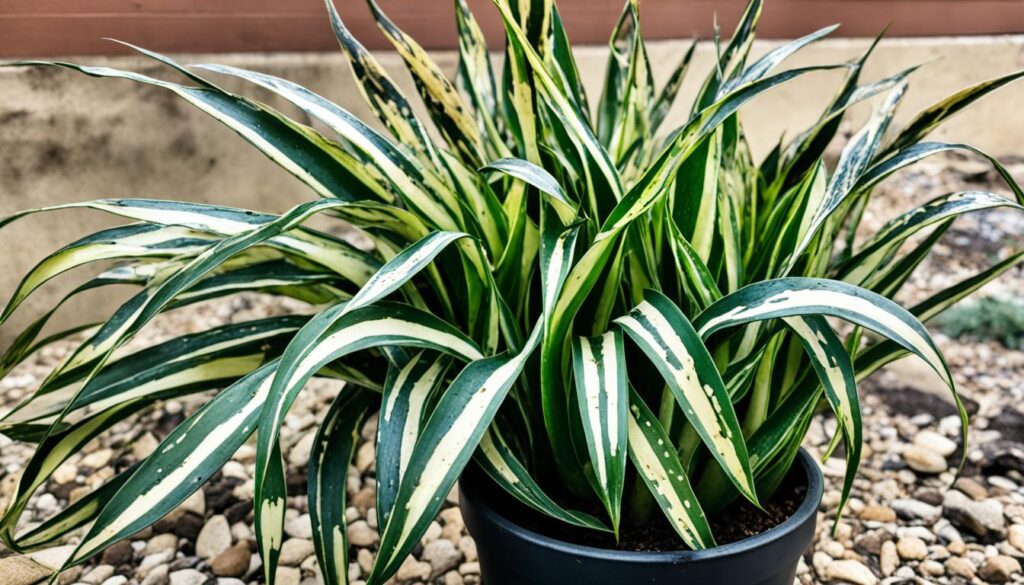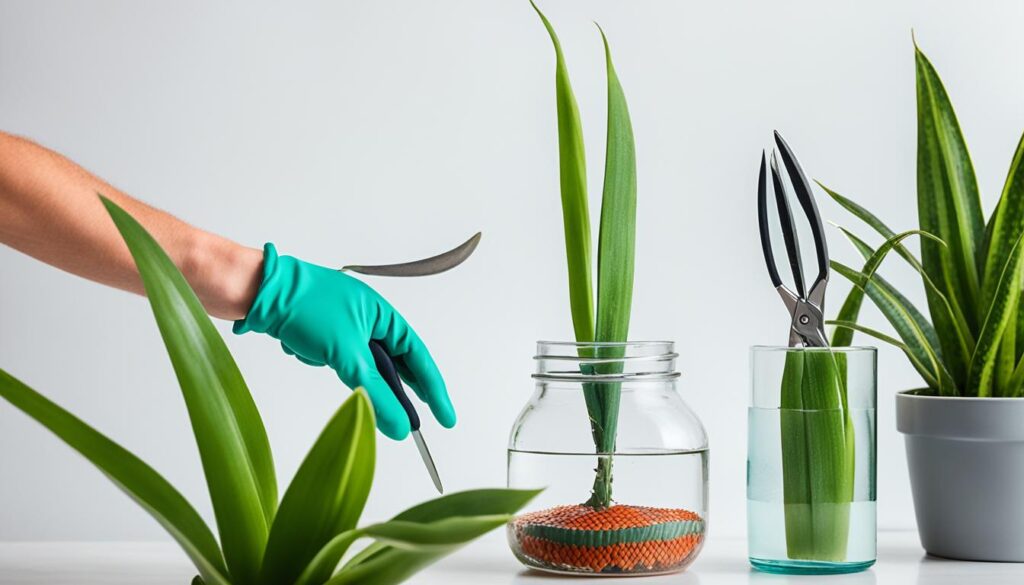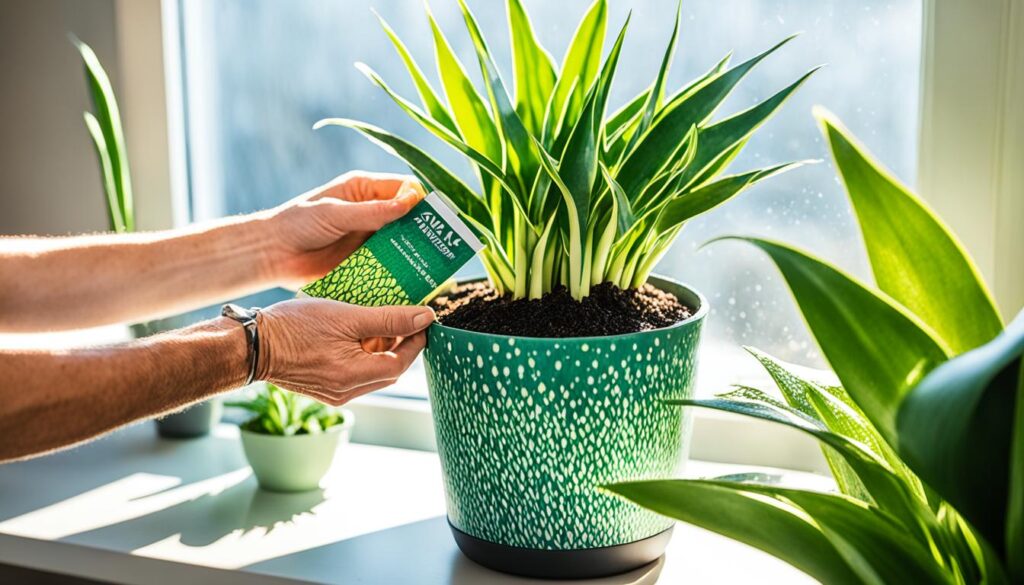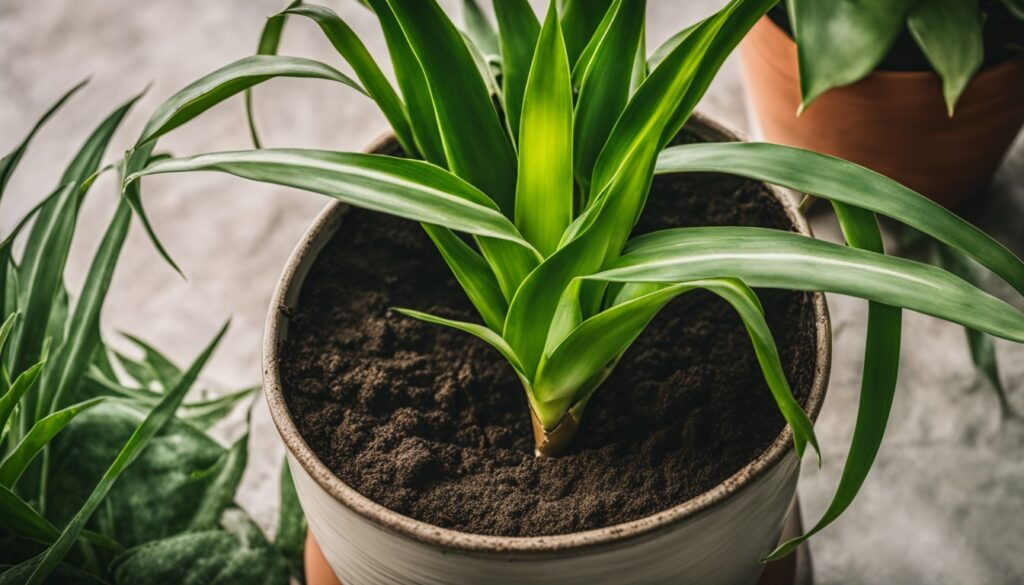Seeing your snake plant leaves fall over can be worrying. These plants are known for being easy to care for and tough. But, they still need certain conditions to thrive. If these needs aren’t met, their leaves might droop or fall.
There are several reasons why snake plants’ leaves might fall over. These include overwatering and underwatering, not enough light, and pests. Knowing the cause helps you fix the problem and get your plant looking great again.
Key Takeaways
- Overwatering is the most common cause of snake plant leaves falling over.
- Insufficient light and underwatering can also lead to drooping or falling leaves.
- Root-bound plants and pests can contribute to the leaves falling over.
- Proper care, including watering, lighting, repotting, and pest management, is crucial for maintaining healthy, upright snake plants.
- Pruning and propagating fallen leaves can be an effective solution to address the issue.
Overwatering: The Primary Cause of Fallen Snake Plant Leaves
One of the main reasons snake plant leaves fall over is overwatering. Snake plants, like other succulents, store water in their leaves. They need less water than many houseplants. If you overwater a snake plant, the soil gets soggy. This stops the roots from breathing, causing root rot and the plant’s death.
Signs of Overwatering
Snake plants show signs of overwatering, like:
- Yellow or brown, squishy leaves that appear wilted or rotting
- Black, mushy spots on the foliage
- A general lack of vigor and overall decline in the plant’s health
How to Revive an Overwatered Snake Plant
If your snake plant is overwatered, act fast. Cut off any damaged or rotting leaves to their base. Let the soil dry out completely, which might take up to a week. After the roots dry out, put the plant in fresh, well-draining soil and bright, indirect light. Use a diluted, water-soluble fertilizer to help it recover.
“Proper watering is crucial for the health and longevity of snake plants. Overwatering can quickly lead to root rot and the demise of these otherwise hardy succulents.”
Underwatering and Inadequate Light
If your underwatered snake plant lacks water and light, its leaves may fall over. Without enough sunlight, the plant can’t make the energy it needs to stay upright. The leaves will look pale, weak, and grow slowly, then start to droop or flop.
Not enough water also stresses the plant, making its leaves lose strength and fall. The soil might get dry and crumbly, making things worse. Make sure your snake plant light requirements are met by giving it bright, indirect sunlight for at least 6 hours a day. This is best done near an east or south-facing window.
To help a weak snake plant recover from underwatering, soak its roots in water for 5-10 minutes. Then, let the water drain off. Check the soil moisture with your finger before watering again, making sure the top inch is dry. Change your watering schedule to keep the soil from drying out too much, which can cause the leaves to wilt and fall.

“Proper light and water are essential for keeping a snake plant healthy and upright. Without these basic needs met, the plant will struggle and eventually collapse.”
Fixing the underwatering and light issues can help your snake plant get better. Keep an eye on your plant and adjust the watering and lighting as needed. This way, you can keep your snake plant healthy and upright.
Root Bound Snake Plants
If your snake plant’s leaves start to flop or droop, it might mean it’s root bound. This happens when the roots fill the pot and circle tightly. At this point, the plant can’t get the water and nutrients it needs to stay healthy and upright.
Identifying a Root Bound Snake Plant
To see if your snake plant is root bound, take it out of the pot gently. If the roots are packed tightly and fill the container, your plant is likely root bound. You might also notice the soil draining too quickly or the pot cracking, which are signs of a root bound snake plant.
- Roots growing through the drainage holes
- Soil drying out very quickly
- Pot starting to crack or break
- Snake plant falling over or becoming unstable
If not fixed, a root bound snake plant can suffer from nutrient deficiencies and poor water absorption. This can cause the leaves to droop or fall over. It’s crucial to repot the snake plant in fresh, well-draining snake plant soil to keep it healthy.
https://www.youtube.com/watch?v=FnShxIKP98c
“A root-bound snake plant will have roots that fill the entire pot and circle tightly around the space.”
By spotting the signs of a root bound snake plant and repotting the snake plant, you can help it get back on track. This prevents further problems and keeps your plant strong.
Pest Infestations
Pests can make snake plants droop and fall over. These plants face many common pests like scale, spider mites, whiteflies, aphids, and more. These pests are hard to see and can cause spots or damage on leaves.
If pests are not caught early, they can weaken the plant. This can make the leaves fall. It’s important to check your snake plant often for pests. Look for webs, spots, or sticky stuff on the leaves.
- Scale insects attach to leaves and stems, eating the plant’s juices and slowing growth.
- Spider mites create webs and leave a speckled look on the leaves.
- Whiteflies are small and can quickly harm the plant.
- Aphids gather on leaves and stems, sucking the plant’s life away.
- Mealybugs look like cotton balls and can spread fast, causing damage.
To fix a snake plant with droopy leaves, you must act fast. Using insecticidal soap or horticultural oil can get rid of pests and help the plant recover. Ladybugs can also be used to control aphids in a natural way.

“Proper plant hygiene and prompt action are key to keeping your snake plant thriving and pest-free.”
By watching closely and acting quickly, you can keep your snake plant healthy and beautiful. It will add a unique look to your home.
Why is my snake plant falling over?
Random Leaf Falling: A Natural Occurrence
Seeing your snake plant’s leaves fall over can be worrying. But, for the taller varieties, it’s often just part of their growth. The leaves grow tall and their weight can pull them down. This doesn’t mean there’s a problem, unless it happens a lot.
The tall snake plant leaves can get heavy and cause the snake plant leaf drooping or snake plant leaf falling over. This is how the plant sheds leaves to stay balanced and focus on new growth.
“Taller varieties of snake plants are more prone to leaf drooping due to their height and weight.”
To deal with occasional leaf falling, you can support your tall snake plants. Use staking or plant clips to keep them upright. This keeps the plant looking good without harming its growth.
- Embrace the natural leaf shedding process for tall snake plants.
- Provide discreet support, such as staking or plant clips, to maintain the plant’s appearance.
- Avoid over-correcting or constantly trimming fallen leaves, as this can stress the plant.
Understanding that leaf falling is natural helps your snake plant stay healthy and lively. Even as it grows taller.
Pruning and Propagating Fallen Snake Plant Leaves
Don’t worry if your snake plant leaves start to fall. It’s a normal part of their life cycle. You can prune and propagate these leaves to keep your plant healthy and full of life. Here’s how to do it step by step.
Step-by-Step Guide to Pruning
Use sharp pruners to cut the fallen leaves at the soil line. This removes any weak parts. Let the cut ends dry for 2-7 days before replanting to prevent rot.
Propagating Snake Plant Leaf Cuttings
You can grow new plants from the lower parts of pruned leaves. Plant them in well-draining soil or put them in water, covering the bottom of the leaf slightly. Spring and summer are the best seasons for this.
Keep the soil or water moist until roots appear, which may take 1-4 months. Snake plants grow roots slowly, so be patient. With proper care, you can grow new plants from your cut leaves.

“Propagating snake plants via division is faster than using cuttings and helps maintain variegated coloring.”
Pruning and propagating snake plant leaves needs careful attention but is worth it. By following these steps, you can bring new life to fallen leaves and expand your plant collection.
Staking Fallen Snake Plant Leaves
If your snake plant leaves keep falling over, staking them can help. Staking snake plant leaves or supporting snake plant leaves with extra support keeps them upright. This prevents them from drooping or collapsing. Here are ways to stake snake plant leaf support:
- Jute string or twine: Gently tie the leaves to a strong stake or support, being careful not to harm the plant.
- Bamboo skewers or plant stakes: Put these into the soil near the plant’s base, then tie the leaves to them.
- Plant clips or clamps: Use these to attach the leaves to a support like a trellis or cage.
Staking is only a temporary fix. It’s crucial to find out why the leaves are falling over. This could be from too much water, not enough light, or being root-bound. Once the plant is doing well, you can take away the stakes.
“Proper support is essential for Philodendron Xanadu plants to grow upright. Staking is a great way to keep the plant standing tall and improve airflow.”
Staking keeps your snake plant looking elegant and upright while you fix the root problem. With the right support, your snake plant will keep thriving. It will also bring its unique beauty to your indoor space.
Adjusting Light and Temperature Conditions
To keep your snake plant healthy, make sure it gets the right light and temperature. Snake plants love bright, indirect light. They need at least 8 hours of light each day. Put them near a south-facing window for plenty of sunlight but not too much.
Snake plants can handle some direct sun, especially in the morning. But too much can burn the leaves. Keep your snake plant in a spot with temperatures between 70°F and 90°F. Don’t let your plant get too hot or too cold, as this can cause falling leaves.
These plants also like the humidity in your home to be between 30% and 40%. If your home is very dry, you might need to use a humidifier or mist the leaves now and then.

“Adjusting the light and temperature for your snake plant can make a big difference in its health and look.”
By watching and keeping the right light, temperature, and humidity, your snake plant will stay healthy. This way, you can prevent problems like falling leaves and other snake plant care issues.
Repotting and Refreshing Soil
Snake plants are tough houseplants but need repotting now and then. This keeps them healthy and full of life. By repotting them every few years, you give them fresh soil and room to grow.
When to Repot Snake Plants
The best time to repot a snake plant is in spring or summer when it’s growing fast. Look for these signs that your snake plant needs a new pot:
- Roots growing out of the drainage holes
- The plant becoming top-heavy and tipping over
- Soil drying out quickly after watering
- Halted growth or reduced leaf production
- Tightly packed roots in the pot
When you repot, move up one size, like from a 6-inch to an 8-inch pot. This gives the snake plant more room to spread its roots.
After repotting, let the plant settle for a few days before watering. Then, water sparingly, letting the soil dry out between waterings. Avoid direct sunlight and don’t fertilize for a few months to prevent stress.
Proper repotting and soil refreshing are key to keeping your snake plant healthy and long-lived.
Fertilizing Snake Plants for Healthy Growth
Proper fertilization is key for keeping your snake plant looking lush and vibrant. These tough houseplants do well with the right mix of nutrients at specific times. By following a good snake plant care plan, you can make sure your snake plant gets the snake plant nutrients it needs for healthy growth.
For snake plants, the best time to fertilize is in the spring and mid-summer. Use a slow-release fertilizer with a 10-10-10 or similar NPK ratio. But, make sure to dilute it to half-strength before you apply it. This way, you give your plant steady nutrients without risking too much.
- Fertilize snake plants in spring and mid-summer with a balanced, slow-release fertilizer diluted to half-strength.
- Avoid fertilizing snake plants during the winter months when their growth naturally slows.
- Organic options like compost tea or seaweed extracts can also be beneficial for snake plant nutrition.
By following these fertilizing snake plant tips, you’ll help your snake plant stay healthy and look great all year. Remember, it’s important to be careful with how much fertilizer you use. Too much can actually hurt your plant, so always stick to the recommended amount and timing.

“Healthy, well-fed plants are more resilient and better able to withstand pests and diseases.”
Pest Control for Snake Plants
Snake plants need careful watching to stay healthy. They can get pests like spider mites and mealybugs. But, you can fight these pests and keep your plants strong with the right steps.
Using neem oil or insecticidal soap is a great way to control pests. These natural products can be sprayed on leaves and stems. They kill pests without hurting your plant. Misting your plants often with these can stop infestations and keep them looking great.
- Neem oil comes from the neem tree. It’s safe and works well against snake plant pests.
- Insecticidal soap is a soft, plant-based way to get rid of pests like spider mites and mealybugs on snake plants.
Good growing conditions also help keep pests away from your snake plants. Make sure they get enough water, light, and air. Check your plants often and deal with pests fast to prevent big problems.
By staying alert and using natural pest control and good care, you can keep your snake plants healthy and pest-free.
Reviving a Severely Overwatered Snake Plant
If your snake plant has been severely overwatered, you can still save it. The first step is to act fast and give it the right care. This will help the plant recover from the damage caused by too much water.
Step-by-Step Guide to Revival
Start by taking the plant out of its pot and checking the roots. Cut off any roots that are damaged or rotting with scissors. This stops the rot from spreading further. Then, get rid of as much extra water as you can from the pot. You can do this by letting the soil dry out or by changing the wet soil for fresh, dry one.
Let the plant’s roots dry out fully, which might take about a week. Don’t water the plant during this time. It needs this rest to heal. After the roots are dry, put the snake plant in a new pot with a well-draining mix. Use a mix of perlite and peat moss. Give it a light feeding of water-soluble fertilizer to help it get back on its feet.
Put the snake plant in a spot with bright, indirect light and keep an eye on it. With time and the right care, you’ll see new growth. This means the plant has made it through the overwatering and is getting better.


